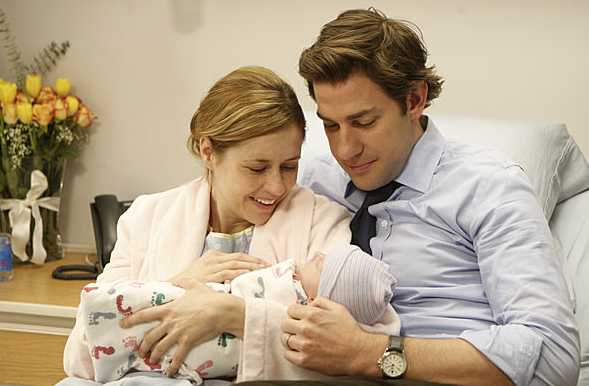TV Treats Breast-Feeding as Comic Fodder

Public health officials have long trumpeted the "Breast is best" message for new moms as a way to promote the health benefits of breast-feeding. On television, though, the message is more like "Breast is awkward."
TV portrayals of breast-feeding are mixed at best, according to a study published online July 2 in the journal Health Communication. Often characters are shown to be uncomfortable in the presence of moms breast-feeding. The study mentions, for example, a scene in the sitcom "Two and a Half Men" in which one of the lead characters, Alan (played by Jon Cryer), dates a single mom who breast-feeds in the restaurant, causing Alan to have trouble eating.
"I found very few representations of women nursing in public, and when they do, it's what the whole episode is about," study researcher Katherine Foss of Middle Tennessee State University told LiveScience. [The Facts on Breast-Feeding (Infographic)]
The stats on breast-feeding
Television shows influence what people see as normal behavior, Foss noted. It's easy to ignore a preachy public service announcement about buckling your seatbelt or quitting cigarettes, but when TV characters wear seatbelts as a matter of course, or refrain from lighting up, it normalizes those behaviors without seeming overbearing, she said.
The public health impact of television is so significant that the Centers for Disease Control and Prevention helps fund the University of Southern California's "Hollywood, Health & Society" program, which connects medical experts with screenwriters in an effort to minimize misinformation on-screen.
Breast-feeding is a personal choice, Foss said, with lots of different factors going into the decision, from the mom's work schedule to her doctor's support to the way people look at her when she needs to feed her baby in public. Still, the benefit of breast milk for babies has been well-established: It boosts their immune systems, is easier to digest than formula, and lowers their lifetime risk of chronic disorders such as asthma and obesity. It may also increase a baby's brain power, according to a study released in 2011 in the journal Pediatrics. The World Health Organization recommends six months of exclusive breast-feeding, followed by breast-feeding with complementary foods up to at least age 2.
Sign up for the Live Science daily newsletter now
Get the world’s most fascinating discoveries delivered straight to your inbox.
In the United States, 75 percent of moms attempt to breast-feed, but only 33 percent do so exclusively for the first three months, according to the CDC's 2012 "Breastfeeding Report Card." By six months, that number is down to 13.3 percent.
Breast-feeding on TV
Normalizing breast-feeding — at home and in public — could go a long way toward making it easier for new moms, Foss said. She decided to look into how television was handling portrayals, and she combed through online TV archives and posting queries on mommy message boards to come up with examples of shows that had referenced or shown breast-feeding.
She found 53 representations, spanning from 1974 to 2012, with portrayals of breast-feeding clearly becoming more acceptable after 1998. (Forty-eight of the 53 examples were found since then.) The shows ran the gamut from dramas such as "ER" to sitcoms like "Friends," "The Big Bang Theory" and "The Office."
Most of the time, Foss said, writers folded a "learning to breast-feed" plotline into stories about characters having babies. In "The Office," for example, the characters Jim and Pam had their first child and had difficulty with nursing. This was played for laughs when their hospital's lactation consultant was revealed to be male, making Jim uncomfortable.
Does it bother you when women breast-feed in public?
After the relative acceptance of breast-feeding in the newborn stage, though, television tends to shy away, Foss found. Characters almost never breast-feed in public, and when they do, other characters comment on it with discomfort. [Cleavage Countdown: 8 Facts About Breasts]
"If it is truly normalized, why are we making such a big deal about it?" Foss said. "It should just be, 'Oh, feeding the baby, just like doing everything else with the baby as part of the show.'"
For example, Foss said, one episode of "Friends" had characters Joey and Chandler becoming uncomfortable when Ross' ex-wife, Carol, breast-fed her son. Ross berated Joey and Chandler for their insensitivity, but Foss said shows would do better to let public breast-feeding pass without comment.
Changing portrayals
Foss, happy to see that portrayals of breast-feeding have become more common, said the representations just need to be "tweaked." She has been in touch with producers on the sitcom "Modern Family" to discuss ways to fold positive breast-feeding messages into the show. The show's season 3 finale revealed that one of the characters is pregnant, making the show a good fit, Foss said.
Though this study focused on fictional television shows, the worst offenders for bad messages about breast-feeding are actually reality shows, Foss said. Those findings will appear in August in a book titled "Beyond Health, Beyond Choice: Breastfeeding Constraints and Realities (Critical Issues in Health and Medicine)," published by Rutgers University Press.
Cable network TLC, which features an array of baby-related programming, is "horrible" at conveying good breast-feeding information, Foss added. She blames advertising dollars from formula companies.
"There aren't a lot of commodities attached" to breastfeeding, she said. "With our commercial society, it's much easier to promote something that has a lot of products that go with it."
Follow Stephanie Pappas on Twitter @sipappas or LiveScience @livescience. We're also on Facebook & Google+.

Stephanie Pappas is a contributing writer for Live Science, covering topics ranging from geoscience to archaeology to the human brain and behavior. She was previously a senior writer for Live Science but is now a freelancer based in Denver, Colorado, and regularly contributes to Scientific American and The Monitor, the monthly magazine of the American Psychological Association. Stephanie received a bachelor's degree in psychology from the University of South Carolina and a graduate certificate in science communication from the University of California, Santa Cruz.

'Mini placentas' in a dish reveal key gene for pregnancy

Diagnostic dilemma: Teen's improbable pregnancy occurred after oral sex









